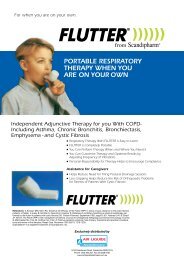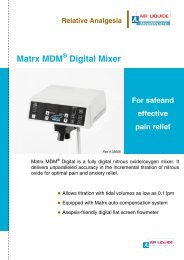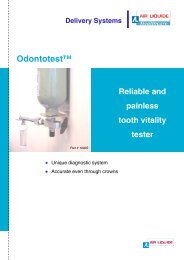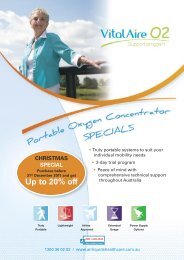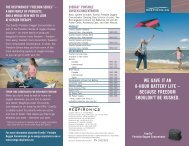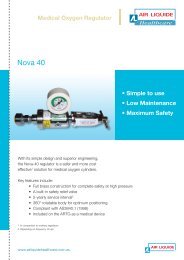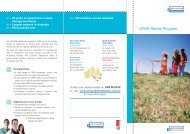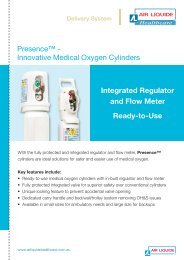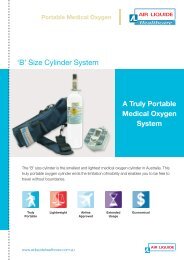nozoil msds - Air Liquide Healthcare Australia
nozoil msds - Air Liquide Healthcare Australia
nozoil msds - Air Liquide Healthcare Australia
You also want an ePaper? Increase the reach of your titles
YUMPU automatically turns print PDFs into web optimized ePapers that Google loves.
ENT TECHNOLOGIES NOZOIL 15ML<br />
Chemwatch Independent Material Safety Data Sheet<br />
Issue Date: 17-Sep-2010 CHEMWATCH 4657-38<br />
NC317ECP<br />
Version No:6<br />
CD 2010/3 Page 1 of 6<br />
Section 1 - CHEMICAL PRODUCT AND COMPANY IDENTIFICATION<br />
PRODUCT NAME<br />
ENT TECHNOLOGIES NOZOIL 15ML<br />
PRODUCT USE<br />
Nasal spray to moisturise inflamed, dry and crusty nasal tissue.<br />
SUPPLIER<br />
Company: ENT Technologies Pty Ltd<br />
Address:<br />
Suite 109/ 12 Cato Street<br />
Hawthorn East<br />
VIC 3123<br />
Telephone: 03 9832 3700<br />
Telephone: 1300 857 912<br />
Fax: 03 9832 3799<br />
Email: info@enttech.com.au<br />
Section 2 - HAZARDS IDENTIFICATION<br />
STATEMENT OF HAZARDOUS NATURE<br />
NON-HAZARDOUS SUBSTANCE. NON-DANGEROUS GOODS. According to NOHSC Criteria, and ADG Code.<br />
RISK<br />
•None under normal operating conditions.<br />
Section 3 - COMPOSITION / INFORMATION ON INGREDIENTS<br />
NAME CAS RN %<br />
No hazardous ingredients present.<br />
Section 4 - FIRST AID MEASURES<br />
SWALLOWED<br />
• Immediately give a glass of water.<br />
• First aid is not generally required. If in doubt, contact a Poisons Information Centre or a doctor.<br />
EYE<br />
■ If this product comes in contact with eyes:<br />
• Wash out immediately with water.<br />
• If irritation continues, seek medical attention.<br />
• Removal of contact lenses after an eye injury should only be undertaken by skilled personnel.<br />
SKIN<br />
■ If skin or hair contact occurs:<br />
• Flush skin and hair with running water (and soap if available).<br />
continued...
ENT TECHNOLOGIES NOZOIL 15ML<br />
Chemwatch Independent Material Safety Data Sheet<br />
Issue Date: 17-Sep-2010 CHEMWATCH 4657-38<br />
NC317ECP<br />
Version No:6<br />
CD 2010/3 Page 2 of 6<br />
Section 4 - FIRST AID MEASURES<br />
• Seek medical attention in event of irritation.<br />
INHALED<br />
• If fumes or combustion products are inhaled remove from contaminated area.<br />
• Other measures are usually unnecessary.<br />
NOTES TO PHYSICIAN<br />
■ Treat symptomatically.<br />
Section 5 - FIRE FIGHTING MEASURES<br />
EXTINGUISHING MEDIA<br />
• Foam.<br />
• Dry chemical powder.<br />
• BCF (where regulations permit).<br />
• Carbon dioxide.<br />
• Water spray or fog - Large fires only.<br />
FIRE FIGHTING<br />
• Alert Fire Brigade and tell them location and nature of hazard.<br />
• Wear breathing apparatus plus protective gloves.<br />
• Prevent, by any means available, spillage from entering drains or water course.<br />
• Use water delivered as a fine spray to control fire and cool adjacent area.<br />
• Avoid spraying water onto liquid pools.<br />
• Do not approach containers suspected to be hot.<br />
• Cool fire exposed containers with water spray from a protected location.<br />
• If safe to do so, remove containers from path of fire.<br />
FIRE/EXPLOSION HAZARD<br />
• Combustible.<br />
• Slight fire hazard when exposed to heat or flame.<br />
• Heating may cause expansion or decomposition leading to violent rupture of containers.<br />
• On combustion, may emit toxic fumes of carbon monoxide (CO).<br />
• May emit acrid smoke.<br />
• Mists containing combustible materials may be explosive.<br />
Combustion products include: carbon dioxide (CO2), acrolein, nitrogen oxides (NOx), other pyrolysis products<br />
typical of burning organic material.<br />
FIRE INCOMPATIBILITY<br />
• Avoid contamination with oxidising agents i.e. nitrates, oxidising acids, chlorine bleaches, pool chlorine<br />
etc. as ignition may result.<br />
HAZCHEM<br />
None<br />
PERSONAL PROTECTION<br />
Glasses:<br />
Not normally required.<br />
Gloves:<br />
When handling larger quantities:<br />
Section 6 - ACCIDENTAL RELEASE MEASURES<br />
MINOR SPILLS<br />
■ Slippery when spilt.<br />
• Remove all ignition sources.<br />
• Clean up all spills immediately.<br />
continued...
ENT TECHNOLOGIES NOZOIL 15ML<br />
Chemwatch Independent Material Safety Data Sheet<br />
Issue Date: 17-Sep-2010 CHEMWATCH 4657-38<br />
NC317ECP<br />
Version No:6<br />
CD 2010/3 Page 3 of 6<br />
Section 6 - ACCIDENTAL RELEASE MEASURES<br />
• Avoid breathing vapours and contact with skin and eyes.<br />
• Control personal contact by using protective equipment.<br />
• Contain and absorb spill with sand, earth, inert material or vermiculite.<br />
• Wipe up.<br />
• Place in a suitable, labelled container for waste disposal.<br />
MAJOR SPILLS<br />
■ Not applicable.<br />
Personal Protective Equipment advice is contained in Section 8 of the MSDS.<br />
Section 7 - HANDLING AND STORAGE<br />
PROCEDURE FOR HANDLING<br />
■ Remove all ignition sources.<br />
• Limit all unnecessary personal contact.<br />
• Wear protective clothing when risk of exposure occurs.<br />
• Use in a well-ventilated area.<br />
• When handling DO NOT eat, drink or smoke.<br />
• Always wash hands with soap and water after handling.<br />
• Avoid physical damage to containers.<br />
• Use good occupational work practice.<br />
• Observe manufacturer's storing and handling recommendations.<br />
SUITABLE CONTAINER<br />
■ Plastic container.<br />
STORAGE INCOMPATIBILITY<br />
• Avoid reaction with oxidising agents.<br />
STORAGE REQUIREMENTS<br />
• Store in original containers.<br />
• Keep containers securely sealed.<br />
• No smoking, naked lights or ignition sources.<br />
• Store in a cool, dry, well-ventilated area.<br />
• Store away from incompatible materials and foodstuff containers.<br />
• Protect containers against physical damage and check regularly for leaks.<br />
• Observe manufacturer's storing and handling recommendations.<br />
Section 8 - EXPOSURE CONTROLS / PERSONAL PROTECTION<br />
EXPOSURE CONTROLS<br />
MATERIAL DATA<br />
ENT TECHNOLOGIES NOZOIL 15ML:<br />
None assigned.<br />
PERSONAL PROTECTION<br />
EYE<br />
■ No special equipment for minor exposure i.e. when handling small quantities.<br />
• OTHERWISE:<br />
• Safety glasses with side shields.<br />
continued...
ENT TECHNOLOGIES NOZOIL 15ML<br />
Chemwatch Independent Material Safety Data Sheet<br />
Issue Date: 17-Sep-2010 CHEMWATCH 4657-38<br />
NC317ECP<br />
Version No:6<br />
CD 2010/3 Page 4 of 6<br />
Section 8 - EXPOSURE CONTROLS / PERSONAL PROTECTION<br />
• Contact lenses may pose a special hazard; soft contact lenses may absorb and concentrate irritants. A<br />
written policy document, describing the wearing of lens or restrictions on use, should be created for each<br />
workplace or task. This should include a review of lens absorption and adsorption for the class of<br />
chemicals in use and an account of injury experience. Medical and first-aid personnel should be trained in<br />
their removal and suitable equipment should be readily available. In the event of chemical exposure, begin<br />
eye irrigation immediately and remove contact lens as soon as practicable. Lens should be removed at the<br />
first signs of eye redness or irritation - lens should be removed in a clean environment only after workers<br />
have washed hands thoroughly. [CDC NIOSH Current Intelligence Bulletin 59].<br />
HANDS/FEET<br />
■ No special equipment needed when handling small quantities.<br />
OTHERWISE: Wear chemical protective gloves, eg. PVC.<br />
OTHER<br />
■ No special equipment needed when handling small quantities.<br />
OTHERWISE:<br />
• Overalls.<br />
• Barrier cream.<br />
• Eyewash unit.<br />
RESPIRATOR<br />
The local concentration of material, quantity and conditions of use determine the type of personal protective<br />
equipment required. For further information consult site specific CHEMWATCH data (if available), or your<br />
Occupational Health and Safety Advisor.<br />
ENGINEERING CONTROLS<br />
■ None under normal operating conditions.<br />
Section 9 - PHYSICAL AND CHEMICAL PROPERTIES<br />
APPEARANCE<br />
Clear light yellow liquid; does not mix with water.<br />
PHYSICAL PROPERTIES<br />
Liquid.<br />
Does not mix with water.<br />
Floats on water.<br />
State Liquid Molecular Weight Not Applicable<br />
Melting Range (°C) Not Available Viscosity Not Available<br />
Boiling Range (°C) Not Available Solubility in water (g/L) I mmiscible<br />
Flash Point (°C) >300 pH (1% solution) Not Applicable<br />
Decomposition Temp (°C) Not Available pH (as supplied) Not A pplicable<br />
Autoignition Temp (°C) Not Available Vapour Pressure (kPa) Negligible<br />
Upper Explosive Limit (%) Not Available Specific Gravity (water=1) 0.91- 0.93<br />
Lower Explosive Limit (%) Not Available Relative Vapour Density Not Available<br />
(air=1)<br />
Volatile Component (%vol) Negligible Evaporation Rate Not Applicable<br />
Section 10 - CHEMICAL STABILITY AND REACTIVITY INFORMATION<br />
CONDITIONS CONTRIBUTING TO INSTABILITY<br />
• Presence of incompatible materials.<br />
continued...
ENT TECHNOLOGIES NOZOIL 15ML<br />
Chemwatch Independent Material Safety Data Sheet<br />
Issue Date: 17-Sep-2010 CHEMWATCH 4657-38<br />
NC317ECP<br />
Version No:6<br />
CD 2010/3 Page 5 of 6<br />
Section 10 - CHEMICAL STABILITY AND REACTIVITY INFORMATION<br />
• Product is considered stable.<br />
• Hazardous polymerisation will not occur.<br />
For incompatible materials - refer to Section 7 - Handling and Storage.<br />
Section 11 - TOXICOLOGICAL INFORMATION<br />
POTENTIAL HEALTH EFFECTS<br />
ACUTE HEALTH EFFECTS<br />
SWALLOWED<br />
■ Considered to be non toxic.<br />
Laxative in large amounts.<br />
EYE<br />
■ Although the liquid is not thought to be an irritant (as classified by EC Directives), direct contact with<br />
the eye may produce transient discomfort characterised by tearing or conjunctival redness (as with windburn).<br />
SKIN<br />
■ The material is not thought to produce adverse health effects or skin irritation following contact (as<br />
classified by EC Directives using animal models). Nevertheless, good hygiene practice requires that exposure<br />
be kept to a minimum and that suitable gloves be used in an occupational setting.<br />
INHALED<br />
■ Not normally a hazard due to non-volatile nature of product.<br />
CHRONIC HEALTH EFFECTS<br />
■ Long-term exposure to the product is not thought to produce chronic effects adverse to the health (as<br />
classified by EC Directives using animal models); nevertheless exposure by all routes should be minimised as<br />
a matter of course.<br />
TOXICITY AND IRRITATION<br />
:<br />
■ unless otherwise specified data extracted from RTECS - Register of Toxic Effects of Chemical Substances.<br />
Not available.<br />
No data<br />
Section 12 - ECOLOGICAL INFORMATION<br />
Section 13 - DISPOSAL CONSIDERATIONS<br />
• Recycle wherever possible or consult manufacturer for recycling options.<br />
• Consult State Land Waste Management Authority for disposal.<br />
• Bury residue in an authorised landfill.<br />
• Recycle containers if possible, or dispose of in an authorised landfill.<br />
continued...
ENT TECHNOLOGIES NOZOIL 15ML<br />
Chemwatch Independent Material Safety Data Sheet<br />
Issue Date: 17-Sep-2010 CHEMWATCH 4657-38<br />
NC317ECP<br />
Version No:6<br />
CD 2010/3 Page 6 of 6<br />
Section 14 - TRANSPORTATION INFORMATION<br />
HAZCHEM:<br />
None (ADG7)<br />
NOT REGULATED FOR TRANSPORT OF DANGEROUS GOODS: ADG7, UN, IATA, IMDG<br />
Section 15 - REGULATORY INFORMATION<br />
POISONS SCHEDULE None<br />
REGULATIONS<br />
No data for ENT Technologies Nozoil 15ML (CW: 4657-38)<br />
Section 16 - OTHER INFORMATION<br />
■ Classification of the preparation and its individual components has drawn on official and authoritative<br />
sources as well as independent review by the Chemwatch Classification committee using available literature<br />
references.<br />
A list of reference resources used to assist the committee may be found at:<br />
www.chemwatch.net/references.<br />
■ The (M)SDS is a Hazard Communication tool and should be used to assist in the Risk Assessment. Many factors<br />
determine whether the reported Hazards are Risks in the workplace or other settings. Risks may be determined<br />
by reference to Exposures Scenarios. Scale of use, frequency of use and current or available engineering<br />
controls must be considered.<br />
This document is copyright. Apart from any fair dealing for the purposes of private study, research, review or<br />
criticism, as permitted under the Copyright Act, no part may be reproduced by any process without written<br />
permission from CHEMWATCH. TEL (+61 3) 9572 4700.<br />
Issue Date: 17-Sep-2010<br />
Print Date: 17-Sep-2010<br />
This is the end of the MSDS.



